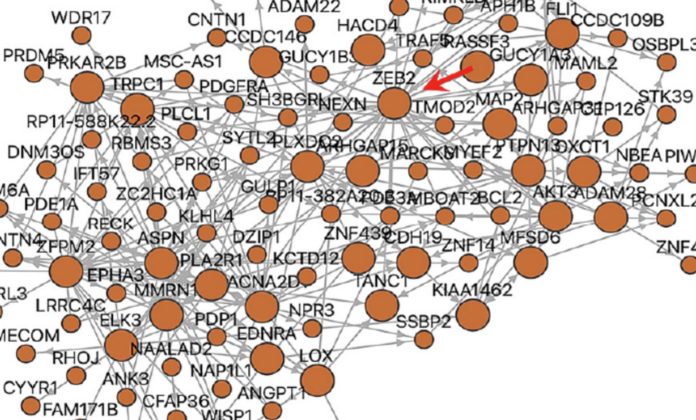For the first time, experts have identified complex networks of genes that can lead to heart disease and can accurately identify people at risk of heart disease.
The discoveries open up a whole new world of possibilities for screening conditions including coronary heart disease, the United States’s biggest killer.
According to the findings, changes in the activity of hundreds of genes working together in networks across numerous organs in the body can explain up to 60% of the risk of coronary heart disease.
Professor Jason Kovacic, Executive Director of the Victor Chang Cardiac Research Institute and co-author of the study, says they now have a clear picture of how these gene networks interact to produce heart disease.
“We have long suspected that the genes we inherit play a far larger role in our chances of developing conditions such as coronary heart disease, but until now we didn’t know just how these genes were working together,” says Professor Kovacic.
“It turns out that there are vast and complex networks of genes at work, which are signaling to one another and for the first time we now have a comprehensive map of how they are operating. This has never been accounted for until now and shines a whole new light on how and why we are predisposed to heart disease.
“This opens up the possibility of being able to far more accurately predict a person’s risk of heart disease, which would allow for earlier assessments and potentially better treatments.”
Coronary heart disease is a complicated disease characterized by thousands of genes that interact with other risk factors such as smoking and obesity, making it difficult and unreliable to screen for the disease. The new discoveries may have a substantial impact on this.
The study comprised 600 people with coronary heart disease and 250 people without coronary heart disease. Their tissue samples were gathered by researchers in the lab of Arno Ruusalepp, MD, PhD, chief vascular surgeon at Tartu University Hospital in Estonia.
Blood, liver, skeletal muscle, visceral abdominal and subcutaneous fat, and two portions of arterial wall obtained from different locations of the heart and blood arteries were used to assess gene activity.
Researchers looked into the various ways that gene activity could be linked to the onset of coronary heart disease. They tested how the activity of all of the disease-related genes was clustered together in different combinations using powerful computer tools.
Although recent studies have shown that about 20% of the risk associated with this disease may be linked to differences in a person’s DNA sequences, the new findings show that 224 gene regulatory networks can explain up to 60% of the risk associated with coronary heart disease, and that many of these networks can help explain disease severity in individual cases. 135 of the networks were restricted to a single type of tissue, whereas the remaining 89 spanned numerous tissues.
Multi-tissue networks appeared to have the most influence. They could account for three times as much illness risk as single-tissue studies. GRN165, one example of a multi-tissue network, accounted for 4.1 percent of coronary heart disease risk and involved 709 genes active in both the artery wall and subcutaneous adipose tissue.
“We found that gene networks work like airplane traffic patterns. Just as a delay at one airport in a key state can disrupt flights in the entire nation, we found that a slight change in the activity of key genes in one tissue can disrupt the activity of other genes throughout the rest of the body,” says Dr. Bjorkegren, from Icahn School of Medicine at Mount Sinai.
Finally, the study found that hormones that aid fat cells in communicating with other organs, particularly the liver, are important in coordinating multi-organ networks. Experiments in mice showed that injections of certain of these hormones changed blood fat and sugar levels, which bolstered this theory.
“This research will be central to the development of ‘precision medicine’ – where patients are diagnosed and treated depending on how their unique genetics interact with risk factors in the environment,” adds Professor Kovacic.
“Here, gene-regulatory networks may play a central role as an explanatory model to be used with the increasingly sophisticated molecular screening tools we have at our disposal today.
“We expect our findings will be translated into the clinical work of diagnosing and treating patients. Indeed, we are already working on this. We believe it’s highly likely that we will be able to map a patient’s gene networks and detect their disease risk.”
This research may also lead to the development of particular medicines for many of the newly discovered gene targets, as well as the ability to change the most important, or apex, genes in each network.
“It may also eventually see us altering problem genes at the top of the gene network, which can impact the hundreds or thousands of genes below, and lessen the risk from certain conditions,” says Professor Kovacic. “In addition, it’s almost certain that these gene networks are critical to many other human diseases like high blood pressure, diabetes, and stroke. So this is the beginnings of a whole new way of working to better understand and treat diseases. The future implications for our patients are enormous.”
Source: 10.1038/s44161-021-00009-1
You were reading: Newly found Complex Networks of Genes can accurately predict a person’s risk of heart disease up to 60%
